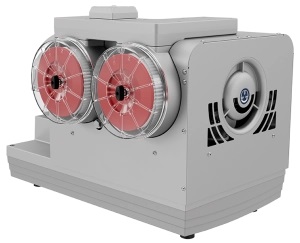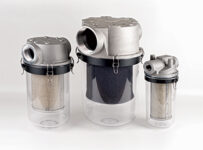Vacuum pump suction cups play an essential role in the design of every vacuum-handling system, linking the vacuum generator and the workpiece.
Benefits of vacuum pump suction cups:
- Wide selection
- Variety of materials for different use
- Various temperature resistance levels
- Perfect adherence even in the presence of edges and angles
Vacuum Pump Suction Cup Function

A suction pad is a gripper that can be used to handle all sorts of objects of different weights, surfaces, shapes, and dimensions.
When selected correctly, vacuum suction cups can hold and manipulate a wide range of objects in many shapes, sizes, and materials.
Vacuum pump suction cups can hold, lift, or turn virtually any kind of material in the production process. The contact between a suction cup and the object to be handled is soft and light, and the technique is simple and safe.
Main types of vacuum pump suction cups include:
Flat suction pads without cleats
Used for handling flat or slightly rounded, rigid, smooth objects. They withstand lateral forces and can be used for vertical handling.
Flat suction pads with cleats
Used for handling thin, flexible, deformable objects. They increase resistance to lateral forces and horizontal handling.
Suction pads with bellows
Used to handle spherical, cylindrical, or egg-shaped objects. The effect of the technical characteristics increases with the number of bellows. They can be used for gripping objects with height differences, for a ball-joint effect, to lift, and to grip corners or edges.
Choosing the Right Material
Which material is right for your vacuum pump system? Cups are made from different composites, depending on the need. Each has a different resistance to wear, tearing, deformation, extreme temperatures, and chemicals. Materials include:
- Polyurethane – very oil resistant
- Butadiene rubber – antistatic properties
- Nitrile rubber – low cost and versatile
- Silicone and Synthetic rubber fluoropolymer elastomer (Viton) – resistant to temperatures
Choosing the Right Size
Regardless of which brand you choose, you should always use the largest vacuum pump suction cup possible to ease the requirements on your vacuum pump system.
Choose the cup size, quantity, material, and style based on:
- Size of the object being handled
- Weight
- Orientation
- Surface temperature
- Conditions
- Space available to mount the cups
Vacuum Cup Holding Force and Velocity Calculation
Vacuum suction cups may need to accommodate round, inclined, curved, and irregular surfaces, so it’s very important to choose the most appropriate type of vacuum suction cup for your specific needs.
The selection of a suction cup depends on particular conditions such as surface quality and structural stability of the workpiece to be lifted and the desired material, shape, etc. of the suction cup. However, a simplified formula can be used to generate a theoretical estimate based on a few known values.

F = P x A
| F = | Weight of the object in pounds or grams |
| P = | Expected vacuum level in PSI or MPa |
| A = | Effective area of the vacuum suction cup measured by in2 or mm2 (Effective area will differ from area calculated directly from physical cup diameter. See manufacturer’s documentation. Some manufacturer’s like Festo will provide holding force values directly at a reference pressure for a given cup) |
By using a larger vacuum pump suction cup, it’s possible to manipulate a heavier object using the same pressure. Conversely, a smaller vacuum pump suction cup requires a greater vacuum level to lift the same object. Keeping the pressure low not only helps ensure long pump life but also greatly decreases energy requirements, since the vacuum force and the energy needed to produce that force don’t scale linearly.
Acceleration = Velocity / Time
To take into account both the acceleration of the vacuum-handling system and gravitational acceleration, the following holding-force formula can be used in situations with a horizontal vacuum suction cup and a vertical direction of force:
- FH (theoretical holding force) = the required theoretical holding force acting perpendicular to the workpiece surface, in Newtons (N).
- m (mass) = Volume of the object multiplied by its material density, measured in grams.
- g (gravity) = Gravitational acceleration (9.8 m/s2).
- a (acceleration) = Change in velocity of a moving object with respect to time (m/s2).
- S (safety factor) = How much stronger the vacuum-handling system needs to be.
The safety factor in high-speed swinging or swiveling operations should be 2.5 or higher.

Learn how we helped a CNC company
build a custom vacuum pump solution.
Suction Pad Force Calculation
The force of a suction pad is proportional to its surface under vacuum and also depends on its shape, flexibility, material, and especially on the level of vacuum attained inside the suction pad.
Theoretical force
. F(DaN) = Surface of the suction pad (cm2) x Percentage of vacuum (%) x 0.01013
The force given in the COVAL suction pad tables is the force of the suction pad measured in practice at 65% vacuum. This figure also includes a safety factor of 2.
Actual force
As its name implies, this force represents the actual force of the suction pad when in use. In general, this is 50% less than the calculated theoretical force.
This difference is explained by the distortion of the suction pad during handling (which reduces the gripping surface), and by the condition of the surface of the object being handled.
The safety factor
All the forces are given in the tables for the various ranges of suction pad. These are actual values at 65% vacuum, calculated with a safety factor of:
- . 2 for horizontal gripping,
- . 4 for vertical gripping,
For applications involving high acceleration, the safety factor will be calculated accordingly.
Diameters
The force of the suction pad and the product’s available gripping surface depends on this parameter. COVAL offers standard suction pads of 1 to 600mm in diameter over all its ranges.
Selecting the Best Vacuum Pump Suction Cup for Your Application
Despite seeming a small part of your vacuum, suction cups are just as important for the smooth operation of a vacuum-handling system as grippers themselves.

WE BELIEVE IN
PARTNERSHIP
Today, vacuum suction cups are available in a broad range of materials, shapes, and sizes, which must be carefully selected based on the intended application.





